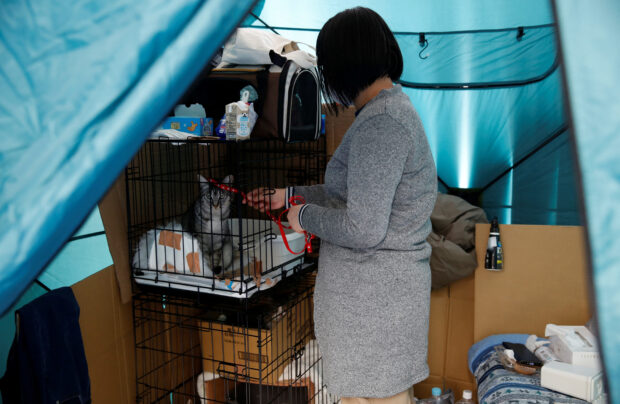Fatigue sets in for Japan quake survivors facing long road to recovery

Earthquake evacuee Yoshimi Tomita plays with her cat Raito after surviving an earthquake that hit on New Year’s Day, at a pet-friendly evacuation centre in Suzu, Ishikawa Prefecture, Japan, January 31, 2024. REUTERS
SUZU, Japan — Moments after a magnitude 7.6 earthquake struck western Japan on New Year’s Day, Yoshimi Tomita was trapped in the dark under the roof of her collapsed house, feeling the sharp edges of protruding nails.
“I was thinking, if I’m going to get crushed I hope it’s fast,” the 35-year-old said.
She was rescued 10 hours later without any major injuries, but that proved to be only the beginning of weeks of fatigue and stress, Tomita said on Wednesday, while sitting in a tent at an evacuation centre in hard-hit city Suzu, surrounded by cardboard boxes used as a makeshift bed.
A month after the earthquake, residents of the devastated Noto peninsula still have little choice but to press on without basic necessities like running water or beds.
Their undesirable housing options range from dealing with continuous aftershocks in shaken homes, moving to crowded evacuation centers that may not take their pets or spending nights in cars fighting the cold.
Article continues after this advertisementMore than 230 people died in the earthquake, Japan’s deadliest in eight years. It left 44,000 homes fully or partially destroyed while 40,000 still have no running water.
Article continues after this advertisementMore than 13,000 residents are living in evacuation centers, according to the Ishikawa prefecture’s government, which has begun a program to build about 13,000 temporary homes over the next few months.
But in places like Wajima, one of the hardest-hit cities on the peninsula, fewer than 20 such homes have been built so far, with more than 4000 applicants waiting for accommodation, according to media reports.
Japan is doing “everything” it can to restore the affected areas and return people to their homes, deputy chief cabinet secretary Hideki Murai said on Thursday.
Meanwhile, locals are still overwhelmed with trying to procure basic necessities.
Tomita rescued two of her four cats after the quake, but the local evacuation centre in Suzu refused to let her stay with her pets, forcing her to sleep sitting up in a car for a month.
She moved into a pet-friendly evacuation centre that opened on Sunday and slept lying down for the first time in weeks that evening.
“If I hadn’t made it to this centre, I feel I might have buckled” under the mental strain, Tomita said.
Eventually, she wants to move out of the evacuation centre for the freedom of her cats, who now must remain caged or on a leash. But with no word on whether temporary housing will become available to her, she says she has no other option but to stay.
That sentiment was echoed by residents on the other end of the peninsula.
Fumio Hirano, who currently lives in an evacuation centre in Shika, says he has struggled to sleep sharing a room with scores of others, and his days are filled with concerns about how he can stay warm and healthy.
“Right now, we can only think about how we’re going to live today. Maybe in a month we can start thinking about ‘tomorrow’, and in three months we can start thinking about ‘next week’,” he said.